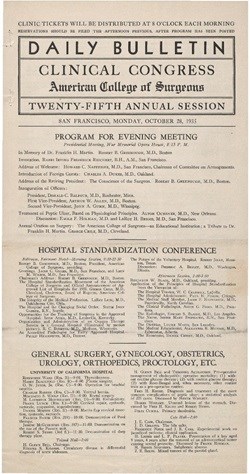San Francisco has long been in rotation as a host city for Clinical Congress. The first Congress was held there in 1935, and, including 2019, ACS has visited an additional 22 times. Congress has been hosted in the “City by the Bay” more times than any other city apart from Chicago, and San Francisco meetings are always well-attended.
Then and Now
Clinical Congress Daily Bulletin, October 28, 1935.
The first Congress held in San Francisco was October 28–November 1, 1935, and it was headquartered at the Fairmont and Mark Hopkins hotels. Registration fees were $5, a double room at local hotels ranged from $4 to $5 per night, and round-trip railway fare from New York to San Francisco was $126.90. At Convocation, 569 candidates were presented for Fellowship.
The 1935 program featured sessions and operative clinical demonstrations held in many Bay Area hospitals, as well as the annual hospital standardization conference, a cancer symposium, a fracture conference, an industrial medicine and traumatic surgery conference, and a community health meeting. This Congress was noted by many to have an expanded focus, which was different from previous meetings. Rexwald Brown, MD, FACS, of Santa Barbara, noted that the first San Francisco meeting “stands out sharpest in my thoughts because its vision was less constrained; more plastic to the reception of ideas other than exclusively surgical ones. […] At this recent session there were numerous instances in which the relationships of the medical, economic, and social setups of medicine and surgery were the subjects of debate.”1 Dr. Brown could not recall there being great interest in or discussion of those issues during past Clinical Congresses.
This trend, first noted in 1935, has continued through today. The College remains at the center of discussions addressing how surgical, economical, and sociological issues intersect, and it has developed programs that address those issues, such as Operation Giving Back, hospital standardization, and our many quality and safety programs.
Today, Clinical Congress not only includes a highly diversified program of continuing education in all specialties, but also addresses the intersection of surgery, science, technology, and socioeconomics. In hindsight, perhaps this echoes back to the shift in perspective noticed at that first meeting in San Francisco.
Defining Moment
An interesting story from a Past-President of the College also has a unique connection to an ACS meeting in San Francisco. Shortly after the 1951 Clinical Congress, several ACS Fellows and their families were traveling back east to their homes via train. During a major blizzard near Evanston, WY, a train from San Francisco collided with a train from Los Angeles. Both trains were carrying surgeons traveling home from Congress. The surgeons aboard the train who survived the crash were able to assist local physicians in helping the injured, but the College tragically lost five Fellows, two of whom had just been initiated, as well as the wives of two of those Fellows.


